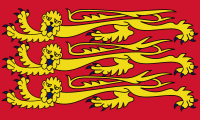
Back Tercera cruzada AN الحملة الصليبية الثالثة Arabic الحمله الصليبيه التالته ARZ Tercer cruzada AST Üçüncü Səlib yürüşü Azerbaijani اۆچونجو صلیبی ساواشی AZB Трэці крыжовы паход Byelorussian Трэці крыжовы паход BE-X-OLD Трети кръстоносен поход Bulgarian তৃতীয় ক্রুসেড Bengali/Bangla
| The Third Crusade | |||||||
|---|---|---|---|---|---|---|---|
| Part of the Crusades | |||||||
 Routes taken by the Crusader armies | |||||||
| |||||||
| Belligerents | |||||||
| Commanders and leaders | |||||||
| Strength | |||||||
|
36,000–74,000 total (estimate)
Two additional contingents also joined Frederick's army while travelling through Byzantine Empire. Numbered about 1,000 men. |
Ayyubids: 40,000 (Saladin's field army, 1189 – estimate)[8] 5,000–20,000 (Acre's garrison, 1189)[9][10] Seljuks: 22,000+ (Qutb al-Din's field army only, 1190)[11][12] | ||||||
| Wars of Plantagenet England |
|---|
 |
The Third Crusade (1189–1192) was an attempt led by King Philip II of France, King Richard I of England and Emperor Frederick Barbarossa to reconquer the Holy Land following the capture of Jerusalem by the Ayyubid sultan Saladin in 1187. For this reason, the Third Crusade is also known as the Kings' Crusade.[13]
It was partially successful, recapturing the important cities of Acre and Jaffa, and reversing most of Saladin's conquests, but it failed to recapture Jerusalem, which was the major aim of the Crusade and its religious focus.
After the failure of the Second Crusade of 1147–1149, the Zengid dynasty controlled a unified Syria and engaged in a conflict with the Fatimid rulers of Egypt. Saladin ultimately brought both the Egyptian and Syrian forces under his own control, and employed them to reduce the Crusader states and to recapture Jerusalem in 1187. Spurred by religious zeal, King Henry II of England and King Philip II of France (later known as "Philip Augustus") ended their conflict with each other to lead a new crusade. The death of Henry (6 July 1189), however, meant the English contingent came under the command of his successor, King Richard I of England. The elderly German Emperor Frederick Barbarossa also responded to the call to arms, leading a massive army across the Balkans and Anatolia. He achieved some victories against the Seljuk Sultanate of Rûm, but he died whilst crossing a river on 10 June 1190 before reaching the Holy Land. His death caused tremendous grief among the German Crusaders, and most of his troops returned home.
After the Crusaders had driven the Ayyubid army from Acre, Philip—in company with Frederick's successor in command of the German crusaders, Leopold V, Duke of Austria—left the Holy Land in August 1191. Following a major victory by the Crusaders at the Battle of Arsuf, most of the coastline of the Levant was returned to Christian control. On 2 September 1192 Richard and Saladin finalized the Treaty of Jaffa, which recognised Muslim control over Jerusalem but allowed unarmed Christian pilgrims and merchants to visit the city. Richard departed the Holy Land on 9 October 1192. The military successes of the Third Crusade allowed the Christians to maintain considerable states in Cyprus and on the Syrian coast, restoring the Kingdom of Jerusalem on a narrow strip from Tyre to Jaffa.
The failure to re-capture Jerusalem inspired the subsequent Fourth Crusade of 1202–1204, but Europeans would only regain the city—and only briefly—in the Sixth Crusade in 1229.
- ^ a b McLynn, Frank (2007). Richard and John: Kings at War (1st Da Capo Press ed.). Cambridge: Da Capo Press. p. 182. ISBN 9780306815799.
- ^ Tyerman, p. 436
- ^ Loud 2010, p. 19.
- ^ Bachrach & Bachrach 2017, p. 197.
- ^ Hunyadi, Zsolt (2011), A keresztes háborúk világa, p. 41.
- ^ McLynn, p. 182: breakdown includes 2,000 Outremer levies, 1,000 Templars and Hospitallers, hundreds of Genoese, Pisans, Danes, and Norwegians, and a small amount of Germans and Hungarians
- ^ Hosler 2018, pp. 72–73.
- ^ Hosler 2018, p. 54.
- ^ Hosler 2018, p. 34.
- ^ Pryor, John H. (2015). "A Medieval Siege of Troy: The Fight to the Death at Acre, 1189–1191 or The Tears of Ṣalāḥ al-Dīn". In Halfond, Gregory I. (ed.). The Medieval Way of War: Studies in Medieval Military History in Honor of Bernard S. Bachrach. Farnham: Ashgate. p. 108.
- ^ Tyerman p. 422: "After desperate fighting involving the Emperor himself, the Turks outside the city were defeated [by the Imperial and Hungarian army], apparently against numerical odds."
- ^ Loud 2010, p. 104: The Seljuks lost 5,000+ men per their own body count estimates on May 7, 1190, soon before the Battle of Iconium.
- ^ Cartwright, Mark (2018-08-27). "Third Crusade". World History Encyclopedia. Retrieved 2021-04-09.